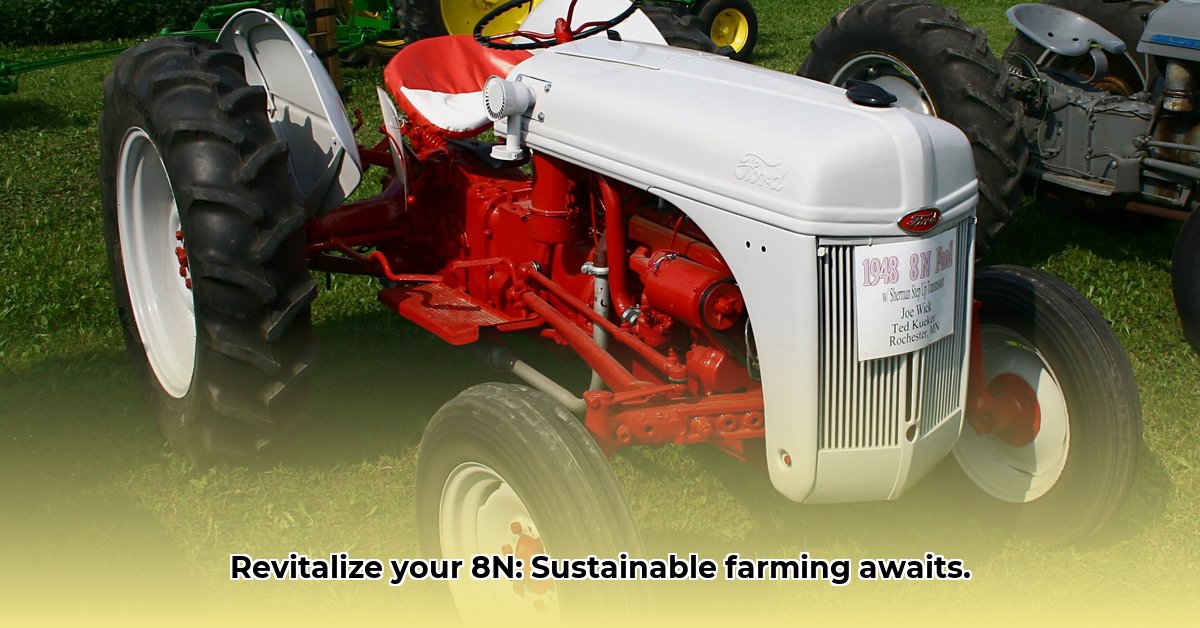
Imagine the satisfying rumble of a vintage Ford 8N tractor, the scent of freshly turned earth, and the quiet pride of cultivating your own food using a machine steeped in agricultural history. This isn't just nostalgia; it's a smart, eco-friendly approach to farming. The Ford 8N, a workhorse of the mid-20th century, is experiencing a resurgence, and this article reveals why – and how you can join the movement. We'll explore its surprisingly green attributes, guide you through restoration, and show you how to integrate this iconic tractor into your sustainable farming practices. For essential parts, check out this helpful resource: 8N parts.
8N Tractor: A Sustainable Farming Revival
The captivating sound of a restored Ford 8N isn't just the soundtrack to a bygone era—it’s a statement about sustainable farming. This robust machine, a symbol of simpler times, provides a pathway to environmentally conscious agriculture.
A Blast from the Past: The Ford 8N's Story
Manufactured from 1947 to 1952, over half a million Ford 8N tractors were produced, shaping modern agriculture with their simple yet effective design. Their enduring popularity reflects exceptional quality and enduring practicality. These weren't disposable machines; they were built to last, a testament to a different era of manufacturing.
Sustainable Farming with a Classic Tractor: More Than Just Nostalgia
Restoring and using a Ford 8N aligns perfectly with sustainable farming principles. This isn't just a charming hobby; it's a conscious choice:
Reduced Manufacturing Impact: Restoring an existing machine drastically reduces the environmental impact compared to purchasing new equipment. You sidestep the significant energy consumption and emissions associated with new manufacturing.
Localized Parts Sourcing: Finding parts often involves local salvage yards and online enthusiast communities, minimizing transportation emissions and supporting local economies. The readily available parts contribute to the tractor's sustainable viability.
Enhanced Repairability: The 8N's relatively simple mechanical design makes repairs easier and more manageable than modern tractors, reducing reliance on expensive specialists and promoting self-sufficiency.
However, the 8N's lower fuel efficiency compared to modern tractors is a crucial consideration. But, we can mitigate this:
- Efficient Work Planning: Careful task planning and consolidation minimizes fuel consumption, maximizing efficiency.
- Exploration of Alternative Fuels: Investigating biodiesel or other sustainable fuels can significantly reduce the carbon footprint. Further research in this area is ongoing, constantly revealing new possibilities. This is a vital area to explore for maximum environmental impact.
Roll Up Your Sleeves: Restoring and Maintaining Your 8N
Restoring an 8N is a rewarding journey, demanding hands-on involvement and fostering a deep connection with your machine.
1. Sourcing Parts: Online forums for classic tractors are invaluable for locating parts, connecting with fellow enthusiasts, and troubleshooting issues. Local salvage yards are often treasure troves of reusable parts. Joining a local club provides valuable support and expertise.
2. Basic Maintenance: Routine oil changes, filter replacements, and regular cleaning are essential for maintaining the tractor’s efficiency and longevity.
3. Troubleshooting: While many resources exist online, from manuals to videos, seeking advice from experienced 8N owners within your community for complex issues is highly recommended. Remember: Safety First. Always disconnect the battery before working on electrical components.
Putting Your 8N to Work: Sustainable Farming in Action
The 8N is perfectly suited for many sustainable farming tasks, especially on smaller-scale operations:
- Tilling: The 8N excels at preparing land for planting, particularly in smaller gardens and fields.
- Planting & Seeding: Appropriate attachments allow efficient planting and seeding.
- Cultivation & Weeding: Its maneuverability makes maintaining crops easier in smaller plots.
The 8N isn't a replacement for modern large-scale equipment. Rather, it's a valuable tool for integrating into a diverse, sustainable farming system.
Connecting with the Community: Finding Support and Resources
Engage the passionate community of 8N enthusiasts. Online forums and local clubs provide a wealth of knowledge, support, and camaraderie.
The True Cost of Sustainability (and the Reward)
While the initial investment varies based on the tractor's condition, ongoing maintenance costs are often lower than modern tractors due to simpler design and readily available parts. Although some repairs might take longer, the long-term savings on fuel and reduced reliance on expensive specialists can significantly outweigh the initial investment.
Staying on the Right Side of the Law: Legal and Regulatory Compliance
Familiarize yourself with local regulations concerning classic tractor operation, including roadworthiness, insurance, and safety standards. These requirements vary by region, so thorough investigation is essential.
Weighing the Pros and Cons: A Balanced Perspective
| Pros | Cons |
|---|---|
| Significantly lower manufacturing impact | Lower fuel efficiency compared to modern tractors |
| Easy access to parts locally and online | Requires more operator skill and attention to detail |
| Simple repairs manageable by many owners | Slower operation compared to modern counterparts |
| Reduced transportation footprint | Potentially higher repair costs in the long run (depending on maintenance) |
| Promotes practical skills | Limited power output, better suited for smaller scale operations |
| Aligns with circular economy principles | Requires more manual labor |
The Ford 8N offers a unique path to sustainable farming, blending classic charm with practical sustainability. It encourages hands-on involvement, fostering a deeper connection to the land. It's more than just a tractor; it's a statement.